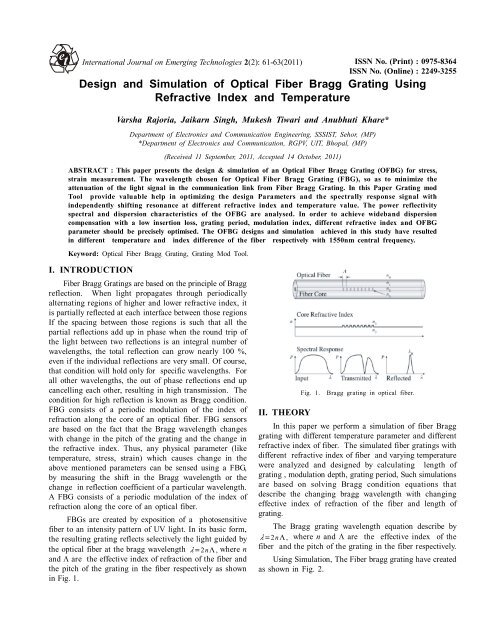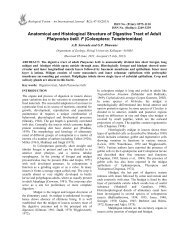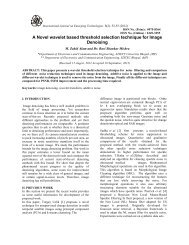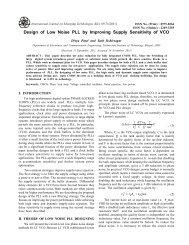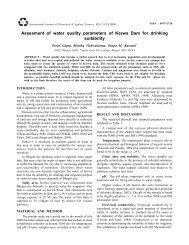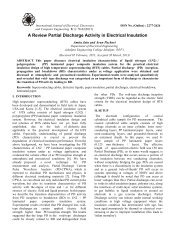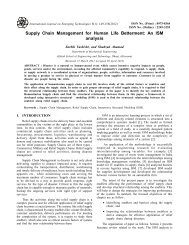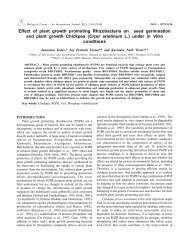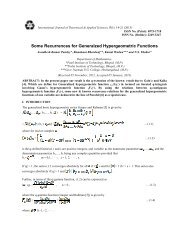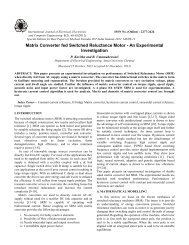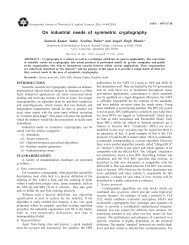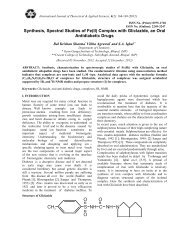Design and Simulation of Optical Fiber Bragg Grating Using ...
Design and Simulation of Optical Fiber Bragg Grating Using ...
Design and Simulation of Optical Fiber Bragg Grating Using ...
You also want an ePaper? Increase the reach of your titles
YUMPU automatically turns print PDFs into web optimized ePapers that Google loves.
e t International Journal on Emerging Technologies 2(2): 61-63(2011)<br />
ISSN No. (Print) : 0975-8364<br />
ISSN No. (Online) : 2249-3255<br />
<strong>Design</strong> <strong>and</strong> <strong>Simulation</strong> <strong>of</strong> <strong>Optical</strong> <strong>Fiber</strong> <strong>Bragg</strong> <strong>Grating</strong> <strong>Using</strong><br />
Refractive Index <strong>and</strong> Temperature<br />
Varsha Rajoria, Jaikarn Singh, Mukesh Tiwari <strong>and</strong> Anubhuti Khare*<br />
Department <strong>of</strong> Electronics <strong>and</strong> Communication Engineering, SSSIST, Sehor, (MP)<br />
*Department <strong>of</strong> Electronics <strong>and</strong> Communication, RGPV, UIT, Bhopal, (MP)<br />
(Received 11 September, 2011, Accepted 14 October, 2011)<br />
ABSTRACT : This paper presents the design & simulation <strong>of</strong> an <strong>Optical</strong> <strong>Fiber</strong> <strong>Bragg</strong> <strong>Grating</strong> (OFBG) for stress,<br />
strain measurement. The wavelength chosen for <strong>Optical</strong> <strong>Fiber</strong> <strong>Bragg</strong> <strong>Grating</strong> (FBG), so as to minimize the<br />
attenuation <strong>of</strong> the light signal in the communication link from <strong>Fiber</strong> <strong>Bragg</strong> <strong>Grating</strong>. In this Paper <strong>Grating</strong> mod<br />
Tool provide valuable help in optimizing the design Parameters <strong>and</strong> the spectrally response signal with<br />
independently shifting resonance at different refractive index <strong>and</strong> temperature value. The power reflectivity<br />
spectral <strong>and</strong> dispersion characteristics <strong>of</strong> the OFBG are analysed. In order to achieve wideb<strong>and</strong> dispersion<br />
compensation with a low insertion loss, grating period, modulation index, different refractive index <strong>and</strong> OFBG<br />
parameter should be precisely optimised. The OFBG designs <strong>and</strong> simulation achieved in this study have resulted<br />
in different temperature <strong>and</strong> index difference <strong>of</strong> the fiber respectively with 1550nm central frequency.<br />
Keyword: <strong>Optical</strong> <strong>Fiber</strong> <strong>Bragg</strong> <strong>Grating</strong>, <strong>Grating</strong> Mod Tool.<br />
I. INTRODUCTION<br />
<strong>Fiber</strong> <strong>Bragg</strong> <strong>Grating</strong>s are based on the principle <strong>of</strong> <strong>Bragg</strong><br />
reflection. When light propagates through periodically<br />
alternating regions <strong>of</strong> higher <strong>and</strong> lower refractive index, it<br />
is partially reflected at each interface between those regions<br />
If the spacing between those regions is such that all the<br />
partial reflections add up in phase when the round trip <strong>of</strong><br />
the light between two reflections is an integral number <strong>of</strong><br />
wavelengths, the total reflection can grow nearly 100 %,<br />
even if the individual reflections are very small. Of course,<br />
that condition will hold only for specific wavelengths. For<br />
all other wavelengths, the out <strong>of</strong> phase reflections end up<br />
cancelling each other, resulting in high transmission. The<br />
condition for high reflection is known as <strong>Bragg</strong> condition.<br />
FBG consists <strong>of</strong> a periodic modulation <strong>of</strong> the index <strong>of</strong><br />
refraction along the core <strong>of</strong> an optical fiber. FBG sensors<br />
are based on the fact that the <strong>Bragg</strong> wavelength changes<br />
with change in the pitch <strong>of</strong> the grating <strong>and</strong> the change in<br />
the refractive index. Thus, any physical parameter (like<br />
temperature, stress, strain) which causes change in the<br />
above mentioned parameters can be sensed using a FBG,<br />
by measuring the shift in the <strong>Bragg</strong> wavelength or the<br />
change in reflection coefficient <strong>of</strong> a particular wavelength.<br />
A FBG consists <strong>of</strong> a periodic modulation <strong>of</strong> the index <strong>of</strong><br />
refraction along the core <strong>of</strong> an optical fiber.<br />
FBGs are created by exposition <strong>of</strong> a photosensitive<br />
fiber to an intensity pattern <strong>of</strong> UV light. In its basic form,<br />
the resulting grating reflects selectively the light guided by<br />
the optical fiber at the bragg wavelength 2 n , where n<br />
<strong>and</strong> are the effective index <strong>of</strong> refraction <strong>of</strong> the fiber <strong>and</strong><br />
the pitch <strong>of</strong> the grating in the fiber respectively as shown<br />
in Fig. 1.<br />
Fig. 1.<br />
II. THEORY<br />
<strong>Bragg</strong> grating in optical fiber.<br />
In this paper we perform a simulation <strong>of</strong> fiber <strong>Bragg</strong><br />
grating with different temperature parameter <strong>and</strong> different<br />
refractive index <strong>of</strong> fiber. The simulated fiber gratings with<br />
different refractive index <strong>of</strong> fiber <strong>and</strong> varying temperature<br />
were analyzed <strong>and</strong> designed by calculating length <strong>of</strong><br />
grating , modulation depth, grating period, Such simulations<br />
are based on solving <strong>Bragg</strong> condition equations that<br />
describe the changing bragg wavelength with changing<br />
effective index <strong>of</strong> refraction <strong>of</strong> the fiber <strong>and</strong> length <strong>of</strong><br />
grating.<br />
The <strong>Bragg</strong> grating wavelength equation describe by<br />
2 n , where n <strong>and</strong> are the effective index <strong>of</strong> the<br />
fiber <strong>and</strong> the pitch <strong>of</strong> the grating in the fiber respectively.<br />
<strong>Using</strong> <strong>Simulation</strong>, The <strong>Fiber</strong> bragg grating have created<br />
as shown in Fig. 2.
62 Rajoria, Singh, Tiwari <strong>and</strong> Khare<br />
III. SIMULATON RESULT<br />
Fig. 2. <strong>Fiber</strong> bragg grating using simultion.<br />
Characteristics <strong>of</strong> OFBG<br />
The grating layout utility is used to speed up the time<br />
needed to produce this type <strong>of</strong> <strong>Optical</strong> fiber bragg grating<br />
for the particular rising temperature <strong>and</strong> different delta value<br />
to set the index. Set the layout option to fiber, the grating<br />
type to volume index <strong>and</strong> the modulation depth to 0.0012<br />
in order to specify that we wish to create an index<br />
modulated fiber structure. Then, set the width <strong>and</strong> height<br />
to 5.25 m, <strong>and</strong> geometry related parameters. <strong>Using</strong> the<br />
rising temperature <strong>and</strong> Different delta value to set the index<br />
(n) gets different form <strong>of</strong> test <strong>of</strong> spectrum response with<br />
central wavelength 1550nm in simulation as shown in table:<br />
Rising temperature<br />
6.6700*10-7 n = 0.0005<br />
6.6800*10-7 n = 0.0002<br />
6.6900*10-7 n = 0.0005<br />
6.7000*10-7 n = 0.0005<br />
6.7100*10-7 n = 0.0003<br />
For different simulation test,<br />
the different delta value to<br />
set the index (n)<br />
Fig.3 (a). <strong>Simulation</strong> result for test 1 between Wavelength <strong>and</strong><br />
Reflectivity power.<br />
<strong>Simulation</strong> Parameter :<br />
Parameter<br />
Setting<br />
Index modulation 0.0012<br />
Central wavelength 1550<br />
Refractive index <strong>of</strong> fiber core 1.456<br />
Refractive index <strong>of</strong> fiber cladding 1.458<br />
Length <strong>of</strong> grating<br />
1mm<br />
Length <strong>of</strong> period <strong>of</strong> N<br />
10,000 period<br />
<strong>Grating</strong> period/<strong>Grating</strong> Length Appro. 0.534µm<br />
Fig.3 (b). <strong>Simulation</strong> result for test 4 between Wavelength <strong>and</strong><br />
Reflectivity power.<br />
Table 1. Dependence <strong>of</strong> reflectivity on grating length<br />
<strong>and</strong> index difference<br />
FBG n:0.0005 n:0.0002 n:0.0005 n:0.0005<br />
=0.0012 =0.0012 =0.0012 =0.0012<br />
L mm R R R R<br />
1 94.65% 93.76% 98.51% 96.43%
IV. CONCLUSION<br />
The results <strong>of</strong> fiber <strong>Bragg</strong> grating simulation shows<br />
that spectral properties <strong>of</strong> grating depends the most on<br />
grating length, L, <strong>and</strong> refractive index change n.<br />
This simulation method shows fundamental<br />
dependences between the grating dimensions <strong>and</strong> its<br />
properties. This is the basic method for making a grating<br />
proposal. This paper presents the optimization <strong>of</strong> length <strong>of</strong><br />
an optical fiber grating for maximum reflectivity <strong>and</strong> minimum<br />
side lobe strength. The performance <strong>of</strong> fiber <strong>Bragg</strong> grating<br />
mainly depends on grating length <strong>and</strong> change in refractive<br />
index. Change in refractive index plays a crucial role in side<br />
lobe strength; it increases with increase in change in<br />
refractive index. It is mainly due to abrupt change in<br />
refractive index at the two edges <strong>of</strong> the grating. The<br />
wavelength 1550nm chosen for analysis is from the third<br />
window to minimize the attenuation. The reflection power<br />
with grating lengths <strong>and</strong> change in refractive index were<br />
analyzed from optical fiber grating index.<br />
V. ACKNOWLEDGEMENT<br />
I would like to express my deep sense <strong>of</strong> gratitude<br />
<strong>and</strong> respect towards my faculty members <strong>of</strong> Dept. <strong>of</strong><br />
EC, Sri Satya Sai Institute <strong>and</strong> Science Technology, Sehore<br />
(MP), for his valuable guidance right from selection<br />
<strong>of</strong> the topic. His constant encouragement <strong>and</strong> support<br />
has been the cause <strong>of</strong> my success in completing<br />
this.<br />
REFERENCES<br />
[1] Ho Sze Phing, Jalil Ali, Rosly Abdul Rahman <strong>and</strong> Bashir<br />
Ahmed Thir: <strong>Fiber</strong> <strong>Bragg</strong> grating modeling, simulation<br />
Rajoria, Singh, Tiwari <strong>and</strong> Khare 63<br />
<strong>and</strong> characterstics with different grating lenths. Journal<br />
<strong>of</strong> Fundamental Sciences 3(2007) 167-175.<br />
[2] Reema Sharma, Rajesh Rohilla, Mohit Shrma, Dr. T.C.<br />
Manjunath: <strong>Design</strong> & <strong>Simulation</strong> <strong>of</strong> <strong>Optical</strong> <strong>Fiber</strong> <strong>Bragg</strong><br />
<strong>Grating</strong> Pressure Sensor for minimum attenuation criteria.<br />
Journal <strong>of</strong> Theoretical <strong>and</strong> Applied Information Technology<br />
© (2005-2009) JATIT.<br />
[3] Yanyu Zhao <strong>and</strong> Joseph C. Palais, Fellow, IEEE: <strong>Fiber</strong><br />
<strong>Bragg</strong> <strong>Grating</strong> Coherence Spectrum Modeling, <strong>Simulation</strong>,<br />
<strong>and</strong> Characteristics. Journal <strong>of</strong> lightwave technology, Vol.<br />
15, No. 1, January (1997).<br />
[4] M. Mahmoud, Z. Ghassemlooy: Tunable <strong>Fiber</strong> <strong>Bragg</strong><br />
<strong>Grating</strong>s Modeling <strong>and</strong> <strong>Simulation</strong>. Proceedings <strong>of</strong> the 36th<br />
Annual <strong>Simulation</strong> Symposium (ANSS'03)1080-241X/03<br />
$17.00 © (2003) IEEE.<br />
[5] Prasant K. Sahu, Sanjay Kumar C. Gowre, S. Mahapatra, J.<br />
C. Biswas: Numerical modeling <strong>and</strong> simulation <strong>of</strong> Fibre -<br />
<strong>Bragg</strong> <strong>Grating</strong> based devices for all-optical communication<br />
network. 1-4244-0340-5/06/$20.00 © (2006) IEEE.<br />
[6] N.H. Sun <strong>and</strong> J.J. Liau, Y.W. Kiang, S.C. Lin, R.-Y. Ro <strong>and</strong><br />
J.S. Chiang, H.W. Chang: Numerical Analysis <strong>of</strong> Apodized<br />
<strong>Fiber</strong> <strong>Bragg</strong> <strong>Grating</strong>s using Coupled mode Theory. Progress<br />
In Electromagnetics Research, PIER 99, 289(306, 2009).<br />
[7] Jaikaran Singh, Dr. Anubhuti Khare, Dr. Sudhir Kumar:<br />
<strong>Design</strong> <strong>of</strong> Gaussian Apodized <strong>Fiber</strong> <strong>Bragg</strong> <strong>Grating</strong> <strong>and</strong> its<br />
applications. International Journal <strong>of</strong> Engineering Science<br />
<strong>and</strong> Technology Vol. 2(5), 2010, 1419-1424<br />
[8] Turan Erdogan: <strong>Fiber</strong> <strong>Grating</strong> Spectra. Journal <strong>of</strong> Lightwave<br />
Technology, Vol. 15, No. 8, August 1997.<br />
[9] Yinghui Cao, Jie Zheng <strong>and</strong> Yushu Zhang: Numerical<br />
modeling <strong>of</strong> fiber grating. Optik - International Journal<br />
for Light <strong>and</strong> Electron Optics Volume 120, Issue 17,<br />
November (2009), Pages 911-915<br />
[10] G. P. Agrawal: Nonlinear <strong>Fiber</strong> Optics. New York: Academic,<br />
(1995).<br />
[11] G. Keiser: <strong>Optical</strong> <strong>Fiber</strong> Communication, McGraw Hill.


